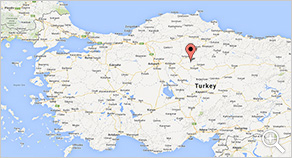HATTUSHA

Hattusha was the capital of the Hittite Empire in the late Bronze Age. It is situated near modern Boğazkale, within the great loop of the Kızıl River in Çorum. There were several other settlements in the vicinity, such as the rock shrine at Yazılıkaya and the town at Alacahöyük.
The first settling around Hattusha took place in the 6th millennium BC during the Chalcolithic period, when small, widely scattered hamlets appeared, most particularly on mountain slopes and rocky outcroppings. Late in the 3rd millennium BC, towards the end of the Early Bronze Age, a Hattian settlement developed, marking the beginning of continuous occupation at the site. Hattusha exerted dominating influence upon the civilizations of the 2nd and 1st millennia BC in Anatolia and northern Syria. The palaces, temples, trading quarters and necropolis of this political and religious metropolis provide a comprehensive picture of a capital, and bear a unique testimony to the disappeared Hittite civilization.
The site, discovered in 1834, was not comprehensively excavated until 1906, which was the memorable date of the discovery of a copy of a peace treaty between Hattushili III and the Pharaoh Ramses II, which made possible the identification of Hattusha. Since then, joint efforts on the part of German and Turkish archaeologists have made decisive progress in knowledge of the Hittite capital. The exploration of Hattusha should serve as a model of long-term archaeological research planning and has given rise to a host of publications and to a specialized periodical issued by the Deutsches Archäologisches Institut.
Hattusha consists of two sites: the Lower City and the Upper City. Visible at the Lower City are the remains associated with civic life. The Great Temple is the principal cult building of the city. Due to its two cult rooms, this temple is believed to have been devoted to the Storm God and Arinna’s Sun Goddess, which were the greatest gods of the Empire.
In the Upper City, the Temple Neighborhood, which encompasses several temples, is noteworthy. The Upper City is situated on a broad arch and was protected by walls to the south. There are five gates on the walls. The Yenikapı ramparts and the sphinx gate stand at the highest point of the city, which is at the southernmost edge of the city walls. King’s Gate and Lion Gate are situated at either end of the southern walls. The Lion sculptures on the outer face of the Lion Gate are some of the best examples of Hittite stone carving.
Yazılıkaya Temple, which is situated 2 km northwest of Hattusha, is considered to be the most significant open air temple of the city. It consists of two rock cut rooms screened off by a single story building reflecting the architectural style of the Hittites. The rock cut rooms of Yazılıkaya Temple are called the “Greater Gallery” (Room A) and the “Lesser Gallery” (Room B).
The Western end of the rook face of the Greater Gallery (Room A) is decorated with a relief of gods, and the eastern end is decorated with a relief of goddesses. The figures of both ends face the central section, where the eastern and western rock faces meet the northern rock face. This is where the main stage was set. The Lesser Gallery (Room B), which has a separate entrance, is protected by a relief of demons with lion heads, human bodies, and wings. The relief decorating the western rock face of Room B depicts twelve gods lined up to their left, and on the eastern rock face there are reliefs depicting a deity-headed upright sword, which is believed to represent the god Nergal of Underworld, and the God Sharrumma escorting King Tudhaliya IV. In this section, besides the well preserved reliefs, there are three rock cut niches. It is believed that these niches were used for placing gifts, or possibly urns containing the ashes of members of the Hittite royal family.
As of today, Hattusha is an open-air archaeological museum and offers visitors a change to trace the history of the Hittite civilization. The site has been on the World Heritage List since 1986.
World Heritage List: Hattusha: the Hittite Capital
Some selected examples (please click on pictures to enlarge):








